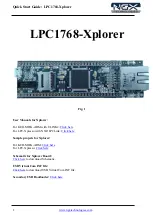
B. Operating Conditions and Audio Characteristics
Parameter
Symbol
Conditions
Min
Typ
Max
Unit
Audio Input Line Level
FSI
VCC=3.3V
0.668
Vrms
Tx In
-3.5
dBV
Audio Output Line Level
FSO = FS
VCC=3.3V
0.741
Vrms
(Left) Rx Out
-2.59
dBV
System Gain FSI to FSO
@ 997 Hz
0.91
dB
SNR A-weighted
SNR
Left CH RE:
>92
dB FS
SNR un-weighted
997 Hz @ FS
>90
dB FS
THD+N Left Channel
THD+N
997 Hz @ -1 dB FS
<0.007
%
Audio Bandwidth
BW
±0.5 dB RE: 997 Hz @ FS
20
15.5K
Hz
Pass Band Ripple
<±0.5
dB
Bonded Current Draw Tx
131
178
229
mA
Rx
137
158
168
mA
Digital Latency *
t
L
9.1
ms
All measurements conducted with AES17 LPF “IN” unless other wise specified.
* Can be customer specified; latency is hard coded in the firmware.
5. RF Test Method and Specifications
A. Test Method
Antenna Orientation
See above diagram for orientation for maximum RF range
performance
Indoor Range*
~25 m line of sight
Tx Setup
~1.3 m high, stationary, powered with 6V DC 400mA power
adaptor
Rx Setup
~1.2 m high, mobile, powered with 4 AA batteries
Office Space
Open design with some cubicles
Office footprint
26 m x 19 m
Notes
• Antenna orientation is important to overall RF range
performance.
• Layout of the testing space affects RF performance.
Reflections of the RF can cause interference.
• Obstacles such as the tester’s body, walls, and cubicles can
affect the range, wherever possible keep node antennas in
line of sight.
• Other RF devices operating in the 2.4GHz spectrum can
affect the RF performance such as microwaves, wireless
routers, and other equipment sharing the 2.4GHz band.
*Range stated is as measured in Eleven Office Space at 9.1ms latency.
B. RF Characteristics & Behavior
The following RF characteristics include pertinent information for FCC, ETSI, and
ARIB STD T-66 regulations for RF devices.
Parameter
Symbol
Conditions
Min
Typ
Max
Unit
Raw Data Rate
Rdr
1.536
Mbps
Total Channels
CH
38
Ch
Hopping Channels
CHh
20
Ch
TX Output Power
Pout
14
15
16
dBm
Antenna Impedance
ZAnt
50
Ω
Frequency Range
2.403
2.479
GHz
Indoor Range*
Ri
25
m
*Range stated is as measured in Eleven Office space at 9.1ms latency, customer range may vary (see Notes in Section
5A).
6. Sales and Support
Sales.
Visit
www.ElevenEngineering.com/Sales & Support/
to find an Eleven
Sales Representative near you, or contact us at
Technical Support.
For all product questions and inquiries visit Eleven's online
support page at
www.ElevenEngineering.com/Sales & Support/
or contact FAE
support at
SP
SP-205 Evaluation Kit Operating Instructions
DO4611
www.ElevenEngineering.com
SP-205 Evaluation Kit Instructions
DO4611|
2009.11.05
Page 4/4






















